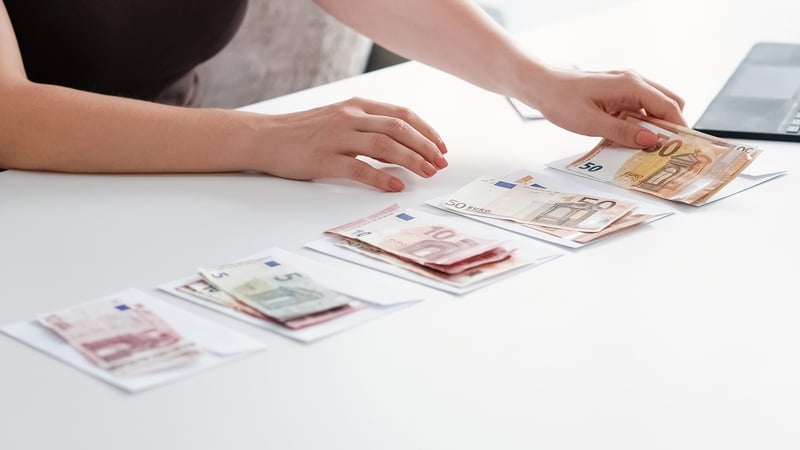Swipe, tap, spend – repeat. In a world where money disappears with a click, a surprisingly old-school budgeting trend is making a major comeback – cash stuffing.
Made popular on platforms like TikTok and Instagram, this method involves dividing physical cash into labelled envelopes or budgeting binders for specific expenses.
What started as a niche personal finance hack has exploded into a movement, especially among Gen Z and millennials looking to regain control of their spending in a world of instant transactions.
How does cash stuffing work?
Cash stuffing is a modern take on the old school envelope system, a simple yet effective method where you withdraw cash and divide it into separate envelopes labelled by spending category – such as rent, groceries, or entertainment.
“At the start of each week or month, you decide how much money you want to spend in each area,” explained Nick Charalambous, Managing Director of financial advisory firm Alpha Wealth.
“Then, you withdraw that amount in euro and “stuff” it into the corresponding envelope.
“The golden rule? Once the money in an envelope is gone, you stop spending in that category until the next budgeting cycle,” he said.
While many people rely on digital tools like budgeting apps or spreadsheets, cash stuffing appeals to those who want to see and feel their money.
“For some, tapping a card or checking an app balance can feel abstract or easy to ignore,” Mr Charalambous said.
“But when you open your groceries envelope and see €40 left, you know exactly what you can afford at the supermarket and you’re far less likely to overspend.”
While this method has long been used by older generations, it has recently struck a chord with younger people in Ireland who are feeling the pressure of the rising cost of living.
What are the benefits of cash stuffing?

There are plenty of reasons people love cash stuffing and for many, it just works.
“I recently overheard a woman in a supermarket say she always brings a set amount of cash on holidays so she doesn’t overspend,” Mr Charalambous said.
“That’s the beauty of this method – it puts real, tangible limits on your spending.”
For anyone who finds themselves a bit “tap happy” on a night out or during an online shopping scroll, cash stuffing acts as a simple but effective safeguard.
“When the money is gone, it’s gone. No overdrafts. No unexpected bills.
“Cash stuffing is best for those who have a hard time controlling their spending, have a lot of debt or frequently find themselves buying things on impulse,” he added.
What are the main disadvantages?
Like any budgeting method, cash stuffing isn’t without its drawbacks.
While it offers structure and control, it also comes with limitations, especially in today’s increasingly digital world.
For example, it lacks flexibility.
“If an unexpected expense comes up, you might find yourself short in one category and unable to reallocate funds easily,” Mr Charalambous warned.
“It’s also, by nature an old-school method, one that doesn’t always align with the way we shop and pay for things today.
“Digital wallets and banking apps allow instant transfers and easier access to your money when you need it,” he added.
While deposit rates are relatively low, keeping money in the right accounts can help you earn interest, something cash in an envelope simply won’t do.
Also, from a safety perspective, carrying or storing large amounts of physical cash isn’t ideal.
Is cash stuffing the same as the old-school envelope system?

Pretty much. Cash stuffing is essentially a modern rebrand of a budgeting technique that previous generations swore by.
“It mirrors the traditional “envelope system” many households used long before contactless payments and budgeting apps,” Mr Charalambous said.
“Think of your parents or grandparents setting aside envelopes for the bin man, gas man, rent or the childminder – each one holding a set amount of cash for specific weekly or monthly expenses.
“What’s old is new again and with the added flair of TikTok tutorials and colourful budget binders, cash stuffing is enjoying a 21st century revival,” he added.
Is TikTok shaping our financial habits?
Social media is having a significant impact on how people, especially younger generations, approach their finances.
Platforms like TikTok and Instagram have become go to sources for financial tips and trends.
The rise of cash stuffing is a perfect example.
It has gained massive traction online amassing over 3 billion views collectively on TikTok alone.
Rather than turning to traditional financial institutions, many Gen Z and millennials are looking to relatable influencers for practical, bite sized advice.
How do I get started?

If you’re curious about cash stuffing and want to give it a go, the good news is it’s easy to start and doesn’t require anything more than some cash, envelopes and a bit of discipline.
We asked financial advisory firm Alpha Wealth for their top tips to help you get going.
1. Create a financial budget
Before stuffing a single envelope, take a look at your recent bank and credit card statements. Categorise your expenses – groceries, rent/mortgage, utilities, socialising, etc. and total how much you’ve been spending in each area over the last few months. This will give you a realistic starting point for setting limits.
Use the 50/30/20 rule:
50% for needs (rent, utilities, groceries)
30% for wants (dining out, entertainment)
20% for savings or debt repayments
2. Set spending limits by category
Decide how much cash you want to allocate to each category. If you’re hoping to save more, identify areas where you can cut back – even €10 or €20 can add up. For categories with more frequent spending, like groceries or petrol, consider weekly limits to avoid blowing your budget early in the month.
3. Create your envelopes or budget binder
This is the fun part. You can use plain envelopes, colour-coded folders, or buy a budget binder with labelled wallet inserts – popular on TikTok and ideal if you’re on the go. Whatever you choose, the key is to clearly mark each one with its category. If you don’t feel comfortable carrying cash, keep your envelopes at home in a secure place.
4. Withdraw your cash and stuff the envelopes
Once you’ve finalised your limits, calculate the total cash you’ll need for the week or month. Withdraw that amount, sort it into piles, and stuff your envelopes accordingly.
5. Only spend what’s in the Envelope
Discipline is key. When making a purchase, use the relevant envelope. If the money runs out, that’s it until the next cycle. Avoid topping up from other envelopes or reverting to your debit or credit card unless it’s absolutely necessary. If you keep running out too early in certain categories, reassess your spending patterns or consider adjusting your limits.
6. Save your surplus
If you come in under budget and have leftover cash at the end of the month, instead of rolling it into next month’s spending, consider using it to pay down debt or add it to a savings account with interest. Over time, these small wins can help you build towards bigger goals like holidays.
7. Start small
You don’t have to cash stuff your entire budget try just two or three categories like socialising, groceries, or fuel and build from there.




